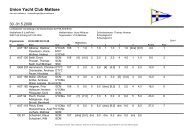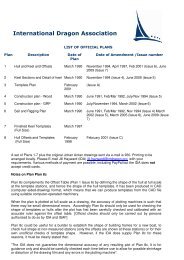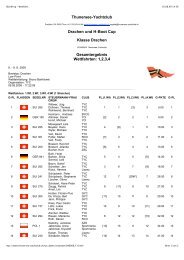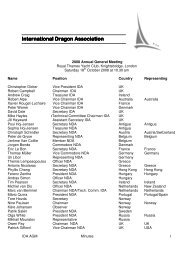2010 REVIEW 2011 PREVIEW - International Dragon Association
2010 REVIEW 2011 PREVIEW - International Dragon Association
2010 REVIEW 2011 PREVIEW - International Dragon Association
You also want an ePaper? Increase the reach of your titles
YUMPU automatically turns print PDFs into web optimized ePapers that Google loves.
From the minister’s lover... to the Europeans on BalatonThe story of <strong>Dragon</strong> sailing in HungaryThe early yearsWe are in 1955, one year beforethe Hungarian revolution.Stalin is dead, the popularityof the communist party is decreasingday by day in Hungary.Yachting is seen as a heritageof the past, a sport made byenemies of the ‘people’s democracy’.Still: no matter whatthey say, the new rulers in thecommunist government knowexactly, how to enjoy life. Andthe Minister for Transport, LajosBebits, decides to have a sailingboat on Lake Balaton, the ‘Hungariansea’. However, he wouldbe despised by his comrades forowning a yacht himself. That is,why the newly built boat wasgiven to his girlfriend, Olga.This is the start of <strong>Dragon</strong>sailing in Hungary. Olga’s boatwith iron frames is being builtin Siófok, the biggest town onthe southern shoreline of the80 kilometre long lake. Whenowned by the Minister’s lover‘Gordius’, was called Vitu, meaning‘We two’. (Bebits used tolive in the USA as a leader ofthe communist party’s Hungariansection there in the 20s, sohe spoke English). The couplehad been sailing with the boatsix years long, and Bebits musthave been very proud of it, as atthe end of the 50s he was HungarianAmbassador to Sweden,Norway and Iceland – where hesaw a large bunch of <strong>Dragon</strong>s atthat time.Gordius/Vitu is registeredPage 18with the Hungarian <strong>Dragon</strong> <strong>Association</strong>as Nr. 2. Unfortunatelywe have not seen her lately butshe still exists. The <strong>Dragon</strong> fleetis, however, very proud of stillhaving its Nr. 1 – Triton. She wasbuilt earlier, some sources say1953, some others 1955 in Budapest.She has recently beenrefurbished again and sailsquite regularly with her proudowners, Balázs Barts and IstvánLukáts.The Golden EraBut the story did not stopwith the lover of the Minister.The sixties brought the GoldenEra of the <strong>Dragon</strong> class in Hungary.In Balatonfüred, the keyyachting centre at the Lake, andSiófok, about 25 boats had beenbuilt in the yards. The shipbuildersused all types of wood thatwas available these times, whenHungary was quite isolatedfrom ‘capitalist’ import sources.Mahogany, okume, oak, cedarand a series of other types oftimber were used for the construction.Unfortunately, in some years copper nails had been unavailable,so the builders used quite often iron nails. This resulted inan erosion of the wooden parts of the boats, forcing the owners tosell these boats at a very low-price in the 80s and 90s.The last wave of the development of wooden <strong>Dragon</strong>s tookplace in the early 70s, when five new boats (Nr. 30 to 34) were builtfor competing in international regattas. They sailed in the Bavarianlakes and even at the Kiel Week. For one or another reason, however,a Hungarian <strong>Dragon</strong> never sailed at the Olympics, and these dreamsvanished with banning the class from the Olympics after 1972. Themost successful Hungarian <strong>Dragon</strong>, Yorikke, built in 1969, won theHungarian Championship 17 times and after her last refit in 2006even sailed in the European Championship in Balatonkenese, <strong>2010</strong>.Rebirth and development until <strong>2010</strong>From the late 70s until the mid 90s the Hungarian fleet did notchange much. The <strong>Dragon</strong> degraded to an ‘old sailor’s boat’, youngsailors tended to choose more interesting classes. A new developmentwas first heralded in when two Hungarian boatbuilders triedto build new GRP <strong>Dragon</strong>s and some quality second-hand boatswere imported in the late 90s.Suddenly, <strong>Dragon</strong> gained an appeal for the sailors. As regattasbecame more and more interesting, talented sailors came into theclass again. Some enthusiasts started to go abroad and sailed inSwitzerland, Germany, Austria. After decades of being away fromthe international <strong>Dragon</strong> circuit, Hungary attended the Europeanson Lake Thun, Switzerland. This was the basis for building up an organizedassociation again.We received much support from Germany, where Sándor Kecskés,an exiled Hungarian, succeeded in persuading his fellow <strong>Dragon</strong>sailors to come and compete in the Hungarian <strong>Dragon</strong> Championshipson Balaton. Sailors from Germany, Switzerland and Austria,


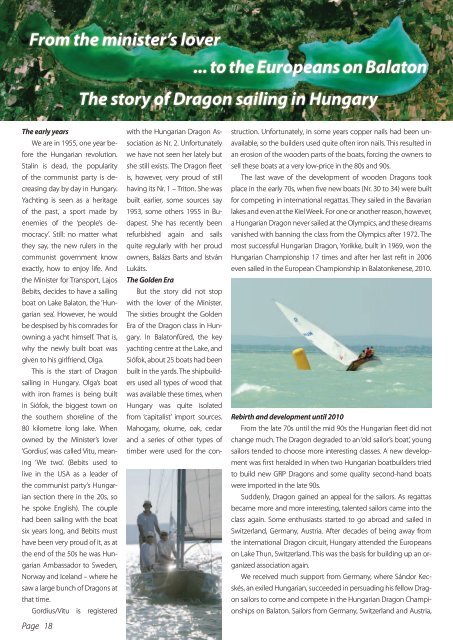

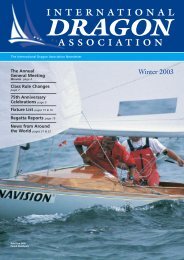
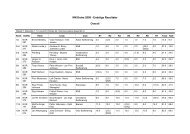
![PP Dragon Gould Cupver 4 [Mode de compatibilité] - International ...](https://img.yumpu.com/35317714/1/190x135/pp-dragon-gould-cupver-4-mode-de-compatibilitac-international-.jpg?quality=85)

